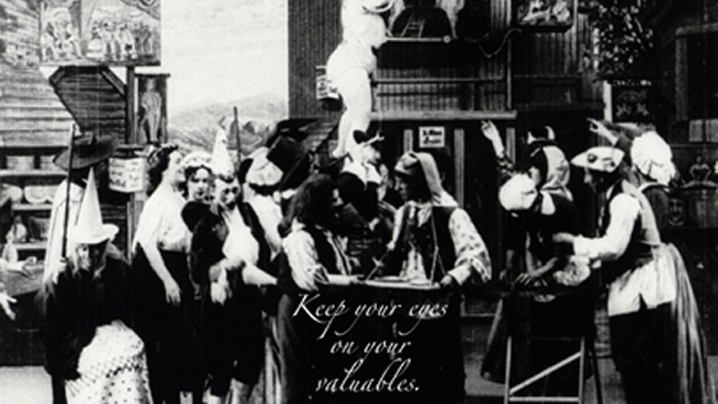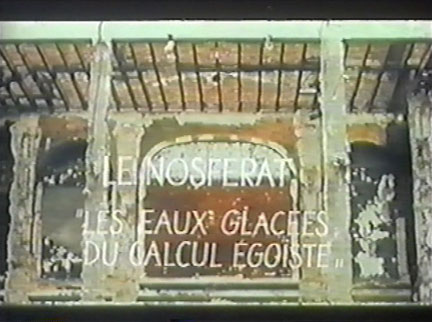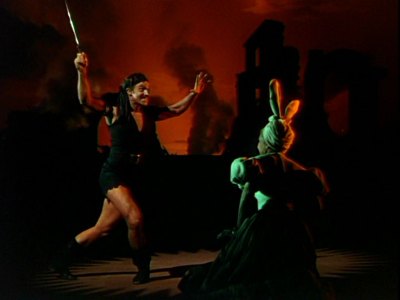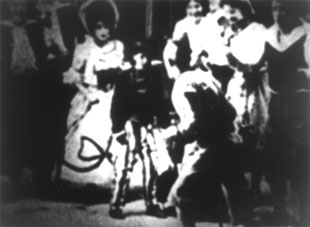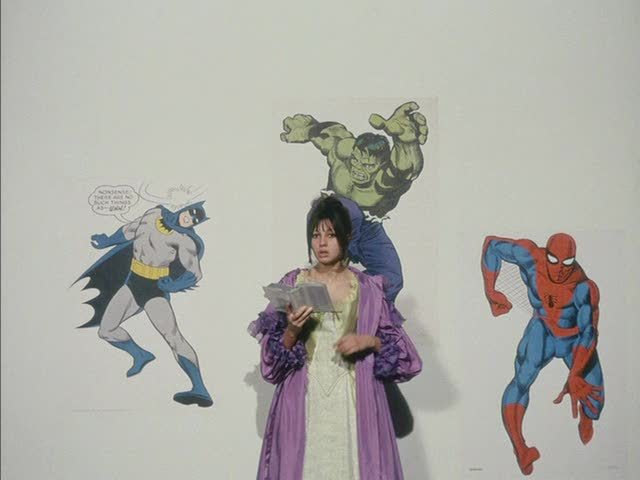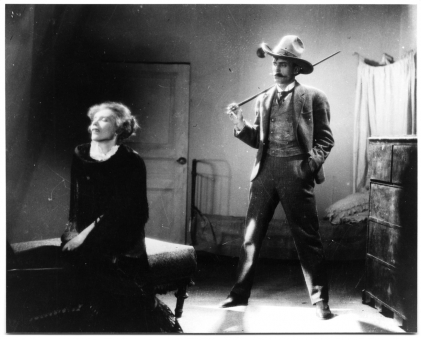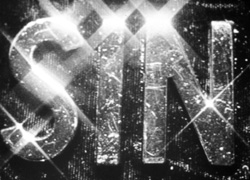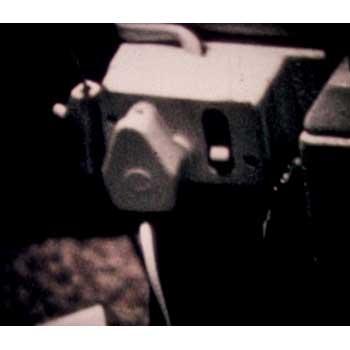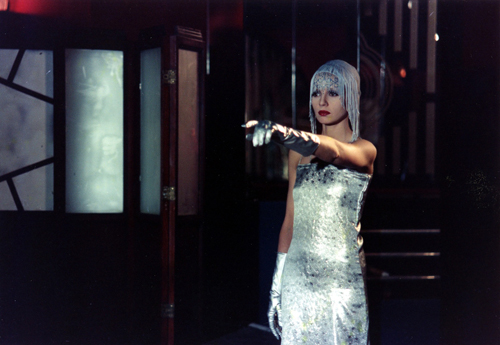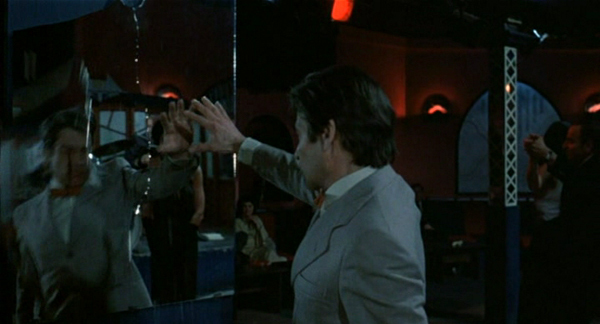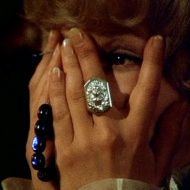I originally planned to include this essay in one of my collections, but eventually changed my mind. It’s an embattled Sight and Sound piece that appeared in their Winter 1976/77 issue and was written towards the tail end of my two and a half years on the staff of that magazine, shortly before I returned voluntarily to the U.S. to accept a short-term teaching job replacing Manny Farber in a San Diego suburb.
In this piece, I castigated mainstream critics for sneering at both the psychoanalytical film theory being practiced at the time at Screen and experimental filmmaking (the focus of each of the two weeks at that year’s Edinburgh Film Festival), at the same time I castigated the organizers of (and many participants in) those two Edinburgh events for various other kinds of narrowness and conformity. What was consciously if paradoxically intended by me as some form of bridge-building between warring factions was in some ways also a kind of bridge-burning, locating myself in the precise middle of the same makeshift and disintegrating bridge I was supposedly trying to construct. In any case, after going to the trouble of retyping this very lengthy report, I found myself too alienated from most of its approach to reprint it in a collection of mine. But I do recognize that as a marker of its now-remote period, it may have some documentary value. Which is why I’m posting it here. –J.R.
Regrouping: Reflections on the Edinburgh Festival 1976
PSYCHOANALYSIS AND THE CINEMA EVENT: In her introductory comments at the opening session, Claire Johnston notes that “a theory of the components of British film culture hasn’t yet been developed,” and an American critic sitting beside me scribbles a furious note: “ I thought this was supposed to be an international conference.”
I sympathize with both positions. Why, after all, does one hear so much talk today about “British film culture” when no one ever seems to speak about French or American “film culture” as such? Could it be because the former doesn’t even exist yet in theory? At best, there’s a series of working hypotheses, which the Edinburgh Festival –- like no other event in the U.K. –- contrives to bring together. And inevitably some of these tend to come out a bit half-cocked and cross-eyed. France, after all, already had a sophisticated “film culture” of sorts half a century ago. Here, in 1976, one is confronted with a good deal of advanced and ambitious theoretical work (particularly in Screen and Afterimage) and a pitifully small amount of practical and historical understanding: two heroic steps forward on one level, three myopic steps backward on another.
OUTSIDE THE EVENT, Le Nosferat: adaptation of a 1973 theater piece, first feature by Belgian director Maurice Rabinowicz. Everyone complains about its slowness, which for me is part of its sinuous charm. The camera prowls around chipped and peeling ruins; an asthmatic accordion plays; an expressionless woman scatters flowers. At some point, after a Madonna exposes her leg and lights up a cigarette, another woman sings a bittersweet Brechtian song about eight little whores (“I am number four”). A mainly nonnarrative film about Jack the Ripper and his stodgy bourgeois family, with speeches largely drawn from Nazi figures; fabulous and funny work done with the actors, strange electronic punctuations on the soundtrack, ritualistic actions endlessly protracted like pedal points…how can I talk about such pleasures coherently in a country that still hasn’t discovered Werner Schroeter, and contents itself with meager substitutes like La Paloma?
Or narcissistic platitudes like Tenderness of the Wolves in place of Le Nosferat? The cultural background needed to support such a film exists in France; here it isn’t even present in theory –- nor, one suspects, will it ever be. And modest delights like this one, rejected by “avant-garde” and “dominant” factions alike, will disappear without trace, another drop in the bottomless bucket of the undefined.
It is important to remember that, starting with Delluc, French film theory grew directly out of confrontations with contemporary works; and starting with Kuleshov and Eisenstein, Soviet film theory grew directly out of a revolutionary social practice. English film theory, in so far as it exists at all, tends to get by on neither, generally attempting a fusion of borrowed elements. This week, it’s Lacan and Metz; last year at Edinburgh, it was Brecht; and Freud, Marx, Althusser, Kristeva, Derrida, Barthes and the Russian formalists comprise essential parts of the background.
One could criticize this pantheon by saying that it relates to “culture.” Not merely “film culture,” and with so much theoretical space to be covered while following these writers (apart from Metz) on non-filmic subjects, cinema itself might turn out to be the neglected wallflower in the debate. And one could be confident in this criticism, were it not for the publication, over the past couple of years, of Stephen Heath’s “Lessons from Brecht” and “Film and System: Terms of Analysis,” Laura Mulvey’s “Visual Pleasure and Narrative Cinema,” and Paul Willemen’s “Reflections on Eikhenbaum’s Concept of inner Speech in the Cinema” in Screen, and Noël Burch and Jorge Dana’s “Propositions” in Afterimage –- to cite only a few obvious touchstones. Each of these articles, whatever else one might say about it, conveys substantial things about films, concretely as well as theoretically, and none of them would have been possible without a study of some of the figures in the “pantheon” listed above.
Which is not to say that obstacles don’t exist –- particularly for an American like myself who wasn’t introduced to serious criticism through an awareness of theory, and who tends to regard such notions as “collective work” as a recipe for conformity more often than creativity. The use of language that many skeptics cite is also a problem — not when it comes to such things as Lacanian terminology (for how could one understand Lacan properly without it?), but rather in the clotted coinages that tend to rise to the surface within such contexts. A few of the ugliest encountered in Edinburgh would include “complexify,” “hierarchizing,” “unusuality,” “narrativization” (although this, at least, doesn’t appear to have an obvious synonym), and, worst of all, “contentist” (as opposed to “formalist”) –- a hideous term for an archaic concept.
At the same time, it would be foolish to try to discredit an entire intellectual movement on the basis of a few individuals who represent it ungracefully — a ploy that is often used. One could argue, too, that some of Stephen Heath’s wordplay justifies comparable stylistic risks by expanding the possibilities of the language at his disposal; as a co-translator of portions of Finnegans Wake into French, he has at least trained in the right school. But not every foray in this direction comes armed with an adequate grasp of style; and an obligatory reading of Orwell’s “Politics and the English Language” by most of the Screen writers might conceivably have a salutary effect.
The notion of language, moreover, is basic to the concerns of this Event. Lacan’s reading of Freud is based on the assumption that the structure of the unconscious is the structure of language –- a reasonable enough premise if one concedes that, as Jan Miel puts it, “all the material available to the analyst is verbal; what is analyzed in the psychoanalytic interview is not the patient’s dreams, but the patient’s report of his dreams.” Combine Freud’s theory of the unconscious with the theoretical practice of structural linguistics and you arrive at Lacan’s starting point.
And what has this to do with cinema? Enter Christian Metz, a film theorist concerned with semiology whose second book (in 1971) was entitled Language and Cinema and who has described his work more recently as a “meta-psychology” of the film spectator. If films can only be perceived through individual readings of them, one has to examine the process of the reading –- how the viewer “constructs” a film at the same time that a film “constructs” the conditions of its viewing. And if a child similarly encounters “language” and assumes an identity at the same time –- whether it’s at the point of being named (a social definition) or at the stage of recognizing himself/herself in a mirror (a psychological definition, which Lacan calls “the mirror phase”) –- the process is theoretically a comparable one, as long as one acknowledges the relationships between films, labels, and mirrors. Thus “Psychoanalysis and Cinema” doesn’t mean a psychoanalysis of cinema (an absurd notion, because Freud’s theory of the unconscious refers only to people, not to artifacts); it means, rather, a study of the structures within which film language operates –- how films produce (or deny) certain meanings. Within such a discussion, one can no longer speak of form or content as static, pre-given values; it is the manner in which each produces the other that one attempts to describe.
“Attempts” is the operative word, and the various papers and discussions of the week succeed or fail on diverse levels in so far as certain moments illuminate or obscure the issues for separate individuals. (1) Speaking for myself, it is impossible to learn anything practical from this experience unless one is willing to wrestle with it on one’s own terms. “Accepting” an inert slab of dogma is out of the question, because everyone involved in the debates is coming at the material from a different angle. There are no “experts” around to mimic: some theorists know little about cinema, some film critics know little about theory, and some of the psychologists and psychotherapists present know relatively little about cinema or theory. And within this Tower of Babel, language (whether it’s the language of the conference or the language of cinema) remains the central issue, even if the cacophony of different tongues, occasionally — and paradoxically — clouds this issue most of all.
OUTSIDE: I’m not sure whether I “like” Lizzie Borden’s Re-Grouping, but I’m less sure whether this matters; it isn’t a film that asks to be liked. An American film that by its own account began as a collective work and then became a “personal” one as Borden proceeded to take it over, it clearly isn’t liked by some of the women who are seen and heard in it. Before the screening, a New York critic publicly conveys no less than nine charges against the film made by one of these women. Foremost among the objections are that Borden received no clearance from any of the people involved, misrepresented the women’s group that the film is “about,” and made a work that is “sexist” and “reactionary”.
Assuming that one could reach any conclusion about the women’s group “represented” in the film, the latter charge might conceivably be justifiable. The fact of the matter is that I can’t –- which is precisely what makes it so fascinating on a theoretical level. Throughout Re-Grouping, one hears off-screen female voices repeatedly and repetitively criticizing the “film” that Borden has made; because this “film” evidently precedes and therefore excludes these criticisms, it clearly isn’t the same film that one is watching and listening to. Analogous displacements inform the discourse at other levels; there is a lot of talk about a woman named Susan who died while the film (or “film”) was being made, and one realizes that she is visible elsewhere, but there is no way one can match up these strains of information to identify her. As film and spectator proceed maddeningly through fade-outs to white, overlapping voices which movie in and out of synch with the visuals, jump cuts and other distancing devices, one gradually realizes that Borden’s title refers not only to the social patterning that forms the film’s ostensible (and elusive) subject, but also to its own manner of presentation. Dissolving “form” and “content” into an impenetrable labyrinth of cross-references to an ungraspable subject, a perpetual “work-in-progress” on the spectator that is never resolved or completed, this diabolical hour of film foregrounds the concerns of the Psychoanalysis Event in a way that Hollywood movies clearly cannot -– by referring directly to its own productions and suppressions of meaning. But it never gets mentioned at any of the morning sessions.
On the other hand, who’s to say that the most useful dividends of the Event have to occur within its own auspices/? Conversations over meals and drinks, when the participants are free to pursue their own “re-groupings,” often prove more stimulating than the seminars, and a similar contradiction applies to most of the films screened within the Event. Excepting only Tom Tom the Piper’s Son and Jeanne Dielman, the choice is strictly Hollywood-auteurist: Sylvia Scarlett, Morocco, The Pirate, The Cobweb, Letter from an Unknown Woman, North by Northwest, The Birds. And for a variety of reasons, the amount of direct enlightenment about these films that emerges seems to be fairly minimal.
One contributing factor is the sheer timidity displayed by most of the papers in encountering films directly; there usually turn out to be at least one or two supportive texts standing in between the analyst and the screen. Correspondingly, the missing references are mainly to films rather than to verbal texts; apart from Stephen Heath, none of the scheduled participants seems comfortable in making these two realms of discourse coextensive within the terms of an argument. Characteristically, Geoffrey Nowell-Smith’s presentation leads off with an excellent summary of Metz’s development, but when he finally makes the leap from Metz to Minnelli, the effect is that of an abrupt plunge. The dance sequences in The Pirate, one learns, are points in the film that allow for the libidinal enactment of fantasies. Beneath the main fiction –- “the story of a woman learning how to love” — is the fantasy of being a pirate, a fiction stated by the film itself rather than by any character. One can nod one’s head dully at this, but the overall impression is that the trip has hardly seemed necessary; to all intents and purposes, the exercise has reverted to an old-fashioned “content” analysis, and due to a shortage of time, The Cobweb never gets mentioned at all.
But a lot of interesting raw material gets set down for inspection and future reassessment during the course of the week, and problems that arise in the papers can be questioned, pursued, and clarified in subsequent discussions –- creating a dialectical chain of ideas that is itself instructive, in so far as it foregrounds the manner in which one’s own understandings get produced. Here again one can speak of certain insights arising independently of the formal meetings; the manner in which the camera pulling back from Gene Kelly at the start of the last scene in The Pirate converts an address to the spectator into an address to spectators in the film, occasioning a curious sense of ease regained; the ways that the meanings of “masculinity” and “femininity” are generated through costume and behavior in Katherine Hepburn’s brilliant performance as Sylvia Scarlett. But the difference between these insights is significant: the first refers to film language, while the second could theoretically apply just as well to the “language” of theater. (Which is not to give Minnelli any points over Cukor; on the contrary, the latter film’s ambiguities and displacements seem considerably richer.)
OUTSIDE: The initial response provoked by festival films such as Cannonball, Nashville Girl, and Hollywood Boulevard is: why? I know that Edinburgh has formerly declared itself “committed” to such commodities as Paul Bartel and New World Pictures, but I can’t quite understand that either, at least as a general principle. If Edinburgh needs a few reliable crowd-pleasers, it can surely do better than this….Second thought suggest the real function of these screenings for the participants in the Event who attend them: simple relaxation. Which might seem fine in theory (or practice), but from the vantage point of the Event is more debatable. If one “relaxes” from a decision to look at films more carefully by essentially junking this position — turning off a battery of mental operations that the Event is supposed to animate — the whole point becomes a bit muddled.
The idea that the Event is “school” and these screenings are an excuse for playing hooky is implicitly encouraged by the daily schedules, and it is hard to imagine a better way of undermining the festival’s ambitions –- unless those ambitions are merely to expose existing contradictions. If Edinburgh fulfilled its radical scenario more completely, one would experience work and play all the time –- more fun at the morning sessions and less of a sense of “slumming” in the evenings. But as thing stand, the fusions of theory and practice tend to be more accidental than inevitable.
Nevertheless, one has to start somewhere. And each day of the Event starts as follows: presentation of a paper, discussion, coffee break, then meetings with smaller “study groups”; after lunch are screenings which relate to the next day’s paper. It is requested that participants stay in their assigned study groups and not switch to other ones –- a rule that I decide to disobey halfway through the week, with few subsequent regrets. My reason for doing so is a wholly subjective feeling of censorship within my first group (although interestingly enough, a Canadian feminist felt the same way about the group that I move into, and has switched herself). Basically this is a matter of group dynamics: despite the presence of articulate spokespeople for avant-garde positions in both groups, it seems that these positions are being generally understood and successfully applied only in the second.
I decide to leave the first after it is collectively decided that the two screenings to be held that afternoon, preceding Stephen Heath’s paper — Tom Tom the Piper’s Son and Letter from an Unknown Woman -– offer too wide a range for concrete discussion, and consequently the group will limit its focus to the latter film. Practically speaking, when the only unequivocal avant-garde film in the Event can be ruled out of order before it’s even seen –- a procedure which closely parallels the operations of “British film culture” at present –- I’d rather seek my edification elsewhere.
Perhaps the most significant “intervention” made during the week was the showing of Ken Jacobs’ seven-year-old Tom Tom the Piper’s Son, if only because of the public response it elicited. Having already seen the film, I stayed away, thereby missing what many observers later described as something close to a riot: spectators who rushed out of the cinema after only a few moments, complaining of headaches; others who stayed and insisted on making a lot of noise. What provoked this hysteria? Jacobs’ silent film, 86 minutes long, begins and ends with the straight presentation of a 10-minute film of the same title, made in 1905 (most likely by Griffith’s cameraman Billy Bitzer) — a comic illustration of the nursery rhyme recorded in eight tableaux by a static camera, basically depicting the chase of a dozen or so people after Tom and the pig that he steals in the opening shot. The remainder of Jacobs’ film proceeds to perform an elaborate analysis of this material by rephotographing it on a screen and examining it with all the filmic means at his disposal: slow, fast, reverse, and stop-motion, cropping, camera movement, masking, “flicker” effects, wipes, superimpositions, and other devices.
A fascinating work of film criticism composed in the language of the medium –- and one that incidentally charts over sixty years of that medium’s visual history –- it is aptly described by Jacobs as a “didactic” film that seeks to “begin to show how much was there” in the original work. And indeed, when the latter is finally repeated as a coda, the effects of Jacobs’ analysis are vividly demonstrated: a charming period piece has been transformed into a work of remarkable density.
Yet apparently the film’s silence, the abstraction of process and detail, the “deconstruction” and reassembly of narrative and illusionist artifice — combined with some of the “flicker” effects –- suffice to make its experience intolerable to most participants in the Event. Having long regarded Tom Tom as one of the most pleasurable and directly accessible of all the “structural” films, I must confess that I remain as shocked and baffled by this rejection as others were shocked and/or baffled by the film. If the only screening within the context of the Event that that made filmic operations legible rather than invisible was enough to confound aficionados of Lacan, Kristeva, and Derrida –- not to mention several Godard enthusiasts –- the pioneering work that remains to be done in even conceiving of a “British film culture” must be awesome indeed.
…It was somewhat bewildering to read about the Psychoanalysis Event afterwards in the national press, where one learned that “the `pleasure principle’ is strictly outlawed from critical practice” and that “semiologist critics” are apparently reluctant to smile; off-putting, in any case, to be told that one hadn’t been having fun after all. These and comparable notations invariably came from critics who contented themselves with the Edinburgh ’76 Magazine and stayed away from the Event, making it possible to imagine anything. Yet by the week’s end, at an uninhibited private party attended by what seemed to be a majority of the Event’s alumnae, it was possible to look back on the proceedings in a much more favorable light. As the week’s tensions dissolved into cheerful and friendly abandon, it eventually became clear that the Event’s frustrations and contradictions had been no less instructive than the more obvious achievements. Putting it all together would take some time; for the moment, it was enough to know that certain essential problems had been aired and recognized.
2
For more reasons that one, the “International Forum on Avant-Garde film” was the portion of the festival that I was particularly looking forward to. The avoidance of this branch of cinema by most of my colleagues has helped to keep a lot of key work unavailable in the U.K., and I welcomed the chance to keep up with recent films by Snow, Godard, Rainer, and others. Equally intriguing was the focus of this Event as originally advertised –- screenings and debates centered on Peter Wollen’s “The Two Avant-Gardes,” a polemical article in Studio International (November-December 1975) seeking to chart out some terms of a possible rapprochement between “two distinct avant-gardes” which currently exist in European film: ‘The first can be loosely identified with the Co-op movement. The second would include filmmakers such as Godard, Straub and Huillet, Hanoun, Jancsó.” A meaty essay, it offered a useful launching pad precisely because it summed up so many aspects of recent thinking in England about the avant-garde.
The ambition to stage an encounter between factions which “[at] the extreme…would tend to deny the [other] the status of the avant-garde at all” seemed wholly admirable; and the fact that Wollen was chiefly responsible for the introduction of avant-garde in Edinburgh last year –- combined with the intelligence that informs much of his writing — made him the ideal person to broach this controversial topic. On the other hand, the more negative side of Wollen’s influence was also worth discussing. Eight years ago, his “Notes towards a Structural Analysis of the Films of Samuel Fuller,” published in the first issue of Cinema, spawned a series of related auteurist studies –- basically old-fashioned thematic analyses of Hollywood films, made more respectable by certain up-to-date methodological trimmings — which established a trend in English film criticism leading away from a close study of film texts (as promoted by Movie) and towards a greater emphasis on theoretical models. An unfortunate side-effect of this tendency — compounded by the conformity of Wollen’s less imaginative disciples –- was a narrowness of reference points that initially skirted the avant-garde entirely, catapulted such neglected figures as Fuller, Sirk, and Tashlin into central positions, and meanwhile excluded some many interesting filmmakers from any kind of consideration that the options of an intellectual “film culture” in England finally seemed to rest on a rather limited and specialized pantheon.
To some degree, Wollen himself has kept ahead of these developments; in other respects his work still reflects them. The potential pluralism implied by “The Two Avant-Gardes” is largely cut short at the roots by a reliance on oracular assertion rather than demonstration. The inclusion of Hanoun or Jancsó is never explained or defended, while the allegedly radical practice of Godard in Le Gai Savoir -– the only film discussed at length – is consistently taken for granted. We’re told that “Godard tries programmatically to ‘return to zero,’ to de-compose and then re-compose sounds and images,’ that ‘the film deliberately suspends “meaning,” avoids any teleology or finality, in the interests of a destruction and re-assembly, a re-combination of the order of the sign as an experiment in the dissolution of old meanings and the generation of new ones from the semiotic process itself.” Yet Wollen never clarifies by citing any specific de-composition, re-composition, suspension, destruction, re-assembly, re-combination, dissolution or generation, attempted or otherwise. (2) A speech describing Godard’s aspirations, quoted from the script –a prime instance of the intentional fallacy –- is used to blanket over the absence of any concrete analysis; and one is left with an idealist gloss that asks and evidently expects to be taken on blind faith alone.
It was my hope, in any case, that such issues and related ones could have been raised at an Event structured around Wollen’s paper. But although no change in policy is announced, and the essay is reprinted without alteration in the Edinburgh ’76 Magazine, the actual event — organized by Wollen and Simon Field, the editor of Afterimage — proves to be quite different. The topics consist of “The Concept of the Avant-Garde,” “The Soviet Avant-Garde of the 20s,” “The Avant-Garde and Language,” “The Avant-Garde and Politics,” and “The Avant-Garde and Narrative”. And the major emphasis is on North American avant-garde (which, according to the essay, is restricted to the Co-op movement), with Americans playing nearly as dominant role as the English played last week.
This, to be sure, has rewards and advantages of its own. But the strategic retreat implied by this maneuver still has ramifications, not least of which is a definition of avant-garde that is essentially traditional and “social” rather than polemical. (Correspondingly, most of the films on view are relatively familiar and predictable – a policy important for laying a certain groundwork, perhaps, but hardly committed to offering or postulating any independent discoveries,) And the ghost of Wollen’s original proposal hovers over many of the proceedings, occasionally taking unexpected and illuminating shapes.
The most informative of the morning sessions I attend is devoted to “Soviet Avant-garde of the 20s,” with Annette Michelson offering a condensed preview of her introduction to Eisenstein’s diary entries on his project to “film” Kapital (a dream that was fed, interestingly, by his fascination with Ulysees) in October no. 2, and Ben Brewster relating Russian films of that period to all the other topics of the Event, largely through the context of a capsule history of the Russian formalist magazine Lef. And on all counts, the most exciting film I see in Edinburgh is Kuleshov’s The Great Consoler (1933), which leads off the Event and, in its own way, relates to all the morning topics as well. Dealing with William Sydney Porter (O. Henry) during his term in an Ohio penitentiary, the film shuttles brilliantly between his relations with one of his own characters (a safecracker and fellow prisoner), a story he writes glamorizing the latter’s exploits, and the effect of the story on a shopgirl –- a relay made all the more unpredictable by the fact that Kuleshov begins with the shopgirl. Addressing not only the issues of narrative continuity and displacement but also the political question of the artist as the “great consoler” (Porter’s story makes it easier for the sheriff to exploit the safecracker, but it ultimately inspires the shopgirl to rebel against her own exploitation and shoot the same sheriff), and the relationship between different kinds of film discourse (intertitles are used in addition to narration and dialogue, and some are complicated further by drawings which complement the texts), it is no less remarkable for its visual style and its uses of sound.
All festivals are conventions in disguise, and a central part of their value is in the casual exchanges that become possible. This is especially apparent during the second week, when the separate parts of the Event fail to cohere in any satisfactory manner. Michael Snow treats me to a cordial and persuasive critique of all the things he found “peculiar” about my account of his Rameau’s Nephew… at last year’s festival (3) — explaining, for instance, that unlike many of his other works, this film isn’t really “about” its specific techniques but about the experiences that derive from them, so that it isn’t necessary to understand the procedures precisely….An anecdote recounted elsewhere — about an intriguing group of silent films made by Navajo Indians, shown one afternoon for the session on “language” — also sticks in the mind. Apparently one of the Navajos made two films, one for his tribesmen and the other for “outsiders”; when the second was shown to his tribe, it was reported that they couldn’t understand it because it was in English.
Snow’s latest short, Breakfast, focuses on an array of unused food and dishes on a table
while one hears the sounds of a radio and dishwashing. A series of odd little events slowly disrupts the complacent stasis of this quaint corner of domesticity: a cup wobbles; eggs roll; the tablecloth moves; a juice carton spills; a plate tilts upward and stands eerily on edge; the carton turns upright again….The solution to this magic comes at the end, when the camera pulls back along the table’s surface to reveal tracking rails, and the title Breakfast (Table-Top Dolly) appears over the image. It turns out that the camera itself, fronted by a sheet of see-through plastic, has been performing all this monkey business. The juxtaposition of “before” (groceries and clean dishes), “after” (sounds of dishwashing), and “in between” (the transformation of a painterly still life into a sticky heap of garbage) gives this modest little demonstration a kind of down-home wisdom that neatly complements its illusionist wit.
Lots of funny movies are on display, a fact that is surprising only in relation to glum ways in which such films are usually described. Annette Michelson’s study of Yvonne Rainer in Artforum (January and February, 1974) is invaluable, yet one would never guess from it how side-splitting the latter’s work can often be. What seems so striking about these films in Edinburgh, along with George Landow’s hilarious patch-quilt oddities like What’s Wrong With This Picture? and Wide Angle Saxon, is the audience rapport they create, a communal experience that one would be hard put to find at screenings of The Exorcist, Jaws, or even Mel Brooks comedies. People make shriek or laugh together at certain commercial films today, but scarcely with the same kinds of warmth or complicity; these are films devoted to feeding myriad forms of alienation, not promoting mutual forms of discovery.
Rainer’s third feature, Kristina Talking Pictures — unlike her Lives of Performers and Film About a Woman Who… — uses verbal texts mainly extracted from other sources (including de Beauvoir, Beckett, Cortazar, Schlovsky, Sontag, Speer, and Verlaine), but her own sense of pop banality and incongruity is so distinctive that it’s usually easy to spot the Rainer lines: “Her face, like Nixon’s, was catching up with her.” “Are you appalled by the torture of political prisoners and jealous of your wife’s success?” “I’d like to see Elvis Presley and Doris Day describing their experiences in Dachau.” “I dreamt I had sex with Marlon Brando. He said, `Why don’t you brush your teeth? You have the breath of a lion.’”
Elsewhere, many of the same motifs (Nixon, lions, political prisoners) and others (like James Cagney) are extended in numerous ways, e.g., echoed or anticipated in photographs on a wall that are sometimes traversed by the camera in the course of pursuing or abandoning other interests. All Rainer’s features are precise, serious/funny portraits of a specific urban-intellectual mentality which offer themselves as multilayered, overlapping “texts”, each layer being isolated as a separate but related discourse — sound as sound versus image – which obliges each spectator to supply the missing connections. A crucial factor is the ironic ambiguity of the verbal and visual elements themselves, which occupy an area where such values as “conscious cliché” and “sincerity” become impossible to disentangle without creative participation. And many (if not all) of the resulting quandaries are marvelously comic, thanks in part to the inimitable dead-pan delivery of the lines and visual clichés.
To my mind, these procedures work most impressively in Film About a Woman Who…, largely because of its ingenious arsenal of “multi-textual” strategies (a sequence of stills illustrating the shower murder of Psycho accompanied by the recitation of another narrative; the camera moving around a woman’s face that is plastered with verbal messages, all declarations of love) and the brilliance of Babette Mangolte’s photography. But all Rainer’s movies are gems: Lives of Performers, which most clearly reflects her dance work, intermingles real and fictional aspects of the roles of herself and her performers in several fascinating ways; and Kristina, containing her first extended work in color, includes at least two sequences as remarkable as anything she’s done. In the first, the camera prowls ceaselessly around a room while “Kristina” wakes and dresses, returning again and again to various key objects and places, and in the course of its journeys scanning successive fragments of a farewell letter from Kristina’s lover Raoul that is lying on the floor — a process threading together the linear “narrative” movements of language and camera in a dazzling manner. The second traces a conversation in which one voice becomes matched in lip-synch with several women while a graceful montage simultaneously parses the phrases and leaps about the room, settling on each “speaker”. Because Kristina is represented by a series of actresses (including Rainer herself, in a long central episode), these sequences exhibit different applications of the same principle, creating and dismantling the pleasures of illusionism and continuity at the same time.
***
During the last session, Peter Gidal reads “The Anti-Narrative: A Condensed Version,” which warns against the recuperation of everything in the avant-garde into narrative. In the discussion, Adriano Aprà -– who, at the first session, attacked the avant-garde for “wanting the safe space of the art gallery rather then the dangerous space of the public theater” — argues that cinema is the only art form of this century to explore the old form of magic, with its elements of fascination and identification. Rainer, who has just read a paper of her own entitled “A Likely Story,” replies that magic is dangerous – it can be used by people to control other people.
Putting these points together, I’m afraid I’ll have to “recuperate” a bit in order to describe my experience of two of Gidal’s films. When he alternately activates and disrupts certain hypnotic forms of fascination in his Room Film 1973 (a film not shown in Edinburgh), I can be drawn into the dialectical pattern, which exerts a “control” over me and then shows me that control. When fascination appears to be assumed rather than created, as in C/O/N/S/T/R/U/C/T (which is shown), I’d rather be somewhere else. The fact that the former traverses indistinct portions of an anonymous room (which isn’t Gidal’s room, as is widely believed), while the latter presents a man putting up a window (as seen through another window) in several overlapping layers, is irrelevant to this question. If the “subject matter” of either film is ultimately the processes that it sets in motion, “narrative” is either the film’s or one’s own record of those processes. By rejecting all notions of narrative and avoiding the issue of fascination in his recent critical writing -– most of which I find harder to “read” than Room Film 1973 –- Gidal effectively outlaws the only kind of pleasure I can find in his films. If C/O/N/S/T/R/U/C/T fails to elicit my fascination, it’s because I’ve failed to locate or collaborate in the construction of its narrative; its conceptual interest, which I interpret as notions about construction and windows (or “windows”), ironically seems too literary.
At the first session, Anthony McCall speaks for “an art that operates from a radical pleasure principle” and “explores social organization,” and I see what he means in his own “film installations” –- works in which the beams of projector light are at least as important as the projected images. Two films are projected in adjacent gallery rooms, and as I join a few others in exploring the shifting patterns of each –- standing inside or outside the casts of light, gazing at the light or the screen from various positions –- the usual divisions of “artwork,” “self,” and “others” no longer seem to apply in quite the same way. There is nothing very intellectual or rigorous about this experience; it is rather like being a child in an amusement park.
Paul Sharits’ Color Sound Frames and Apparent Motion may operate on a much more “radical” pleasure principle, but their sensual delights are much less social. My responses to these abstract “anti-illusionist” works – which present the varying speeds and directions of a succession of individual color frames and a microscopic investigation of film frame, respectively — are again playful, and enormously liberating after the sheer work of following gratuitous plots in the films I am usually glutted with. Their experience is much closer to music than to literature, and I suspect that the rejection of such pleasures by the “dominant” film culture basically rests on the privileged status of the 19th century novel as the ultimate model of excellence.
Writing a year ago about the avant-garde in Edinburgh, I deliberately situation my remarks between positions which I identified with “insiders” and “outsiders”. This time, I feel more like an ambassador from a neutral country, visiting one of the two Major Powers in the midst of a Cold War; needless to say, I feel the same way in London, where the other Power reigns. The sense of mutual antipathy is so strong that one is tempted to think that, as social entities, the two factions need and resemble one another more than either would care to admit; they’re even quite compatible as long as they remain exclusive categories, with fixed ghetto boundaries. “Insiders” might be willing to see Lancelot du Lac, but they aren’t likely to take it seriously. “Outsiders” might be willing to take Wavelength seriously, but they aren’t likely to see it. The whole thing gets a bit wearying if one is finally more interested in films than categories.
My “neutral” peace offering at Edinburgh — or “intervention” — is arranging for a screening of Rivette’s Duelle outside the Event, after being assured that the organizers are unwilling to show it themselves. Particularly because it is a film whose very terms are likely to be misunderstood in an “outsider” context, my assumption is that it might provoke at least curiosity and interest here. By and large, I prove to be mistaken; the most common response I encounter is a reading of Duelle as a “conventional” poetic fantasy à la Cocteau that is “accepted” — hence rejected –- on a purely illusionistic level.
Yet to compare the film to Cocteau — let us say Orphée –- one would first have to outline the processes determining the conditions and boundaries of each. In Orphée, one has to consider a Greek myth filtered through the sensibility of a specific auteur to construct a contemporary legend referring to his own self-definition, his vocation as a poet; and the film (that is to say, the film’s experience) must be located in all the stages of this process, not at some imaginary or idealist end-point conceived as a “product”. Nor surprisingly, the mirror in Orphée – representing the narcissistic relation of auteur and spectator to the screen, if we recall “the mirror phase’ — functions as a locus of passage.
The mirror in Duelle cracks, however, halfway through the film, when the only male hero (Jean Babilée) points at it. Here one must consider a myth-in-progress being constructed moment to moment by a variety of auteurs out of a diversity of sources — organized by one individual who allows for elements of chance (an improvising pianist) as well as control (scripted dialogue) to dictate the terms of that organization. The disparity of the myth’s sources can seen in the goddesses’ names — Leni (Juliet Berto) and Viva (Bulle Ogier) – which evoke the “myths” associated respectively with Leni Riefenstahl and the Warhol Superstar; set against this odd combination are other notions suggesting a “ghost” story (Leni) and a “fairy” tale (Viva). A “transcendental” diamond –- granting life on earth to wealthy goddesses and beatific madness to proletarian mortals – serves as a kind of narrative pretext that, as in Hitchcock’s Family Plot, “directs” the characters with the irresistible precision of a magnet, becoming at once their focal and rallying points –- and, by implication, ours.

The sheer gratuity of this desired object makes it the appropriate emblem of the lure of narrative/illusionist cinema –- why we let ourselves be lulled into “mythical” fictions. If the giant diamond of Family Plot is captured and guarded by the upper-class couple, sought by the police (like the solution to any “mystery”), and ultimately used as the proletarian heroine’s means of deceiving the proletarian hero –- with a wink at the audience paradoxically sealing that deception –- the equally outsize diamond in Duelle, captured by working-class characters and sought by wealthy ones, is altogether more abstract and “theoretical”. It is not exchangeable for money, police are non-existent, and no explanation is offered of why goddesses should want to become earthly, or mortals ethereal: each desire becomes an equivalent form of “madness,” the folie that cinema itself trades on. (The movie star who pretends and/or wants to be a “real” person; the spectator who identifies with screen deities.) Which is only to say that, transcendentally speaking, Hitchcock (like Cocteau) remains the true believer, Rivette the confirmed agnostic, yet both remain equally obsessed with the object of their attention, the screen, fascinated by its glitter.
If Orphée presupposes a firm belief in fiction (myth) as a poetic way of seeing the world, Duelle acknowledges and reactivates the desire for that belief while refusing to satisfy it; the “world” itself remains too unstable, the fiction too artificial. Precisely because what the myth refers back to is so scattered and discontinuous, one has to regard it as something “referring ahead” to a specific set of formal conditions, e.g., the brightness associated with the blonde sun-fairy Viva, the darkness linked to the brunette moon-ghost Leni. The mystery’s solution is nothing but the formulation of these terms, and its “resolution” is simply their dissolution –- the successive elimination of each character; the final blending of light and darkness into the grey cast of dawn. Both of these come together in the film’s chilling, unexpected last cut, from the last mad mortal — the same character who is “unbalanced” on a ball in the opening shot, embodying the spectator’s suspensions –- to the end title, propelling fiction and spectator into the void from which they came. And the sound of a train arriving over the beginning and final credits may suggest another locus of passage; yet here it is impossible to say from where or towards what.
Clearly conceived as an “impossible object” no less than Re-Grouping, Rivette’s disquieting form of aggravation is even given two impossible titles: the feminine form of a masculine noun in French; and in English, a Joycean pun — Twhylight –- conveying both its terms of suspension (a series of whys, for Rivette and spectator alike) and dissolution (dusk equaling dawn). Yet as soon as one converts it from object into process, a sense of the possible –- the fascination of an agnostic for a hypothesis — becomes everywhere apparent. As long as one is willing to contend with the challenge of ambivalent diamonds and shattering mirrors, moving back and forth between illusion and disillusionment, myth and demythification, like a ball in a tennis match, this aggravation can lead straight to lucidity. Like all works that are potentially avant-garde in effect — using that term ahistorically, and again in reference to a process, not an object -– it postulates and defines a new kind of spectator. But this definition is mainly rejected at Edinburgh by spectators who like to keep their narrative illusionism and their avant-garde separate, uncontaminated by any mutual embrace.
A few overall trends become evident over the course of the week –- the sophistication of many avant-garde films by English students, for instance, which I’m told compares quite favorably with their American counterparts. (Christopher Swayne’s Reading, Forgetting… is an especially intriguing example.) Even if a feature like Justine suggests that pre-production discussions were probably a lot more interesting than anything which turns up on the screen, the ambitiousness of such an enterprise seems so admirable in the teeth of such indifference that the mere fact of its existence is somewhat awe-inspiring. Combined with other factors — such as a general demystification of the North American avant-garde, particularly in relation to politics and theory -– this level of aspiration implies that a genuinely independent English cinema may be in the process of formation…or at least formulation.
A solid sense of the English avant-garde’s collective identity does seem to emerge, sparked in part by the arrival of a readable new issue of Afterimage devoted to that subject. (A new number of Framework — more relevant to the concerns of the first week, with an excellent piece by Heath on Jaws — also turns up.) Often a lot calmer, less bullying, and more rigorous than many of the official “stars” at the open discussions, the voices at the back of the room leave a lingering impression. Perhaps this might grow into something even more formidable at next year’s festival…assuming that a conjucture of forces lets it happen.
Notes
1. I won’t try to explain the other specific Lacanian concepts — primary and secondary repression, castration complex, etc. – that Rosalind Coward takes up in her introductory essay in the Edinburgh ’76 Magazine (which also contains most of the other papers in the Event, along with an essay by Kristeva, Wollen’s “The Two Avant-Gardes,” and useful bibliographies. Unlike Robin Wood in the Times Educational Supplement, I don’t feel that this presupposes ‘a thorough knowledge of both psychoanalytical and semiological concepts and terminology,” tools which I flagrantly lack. Despite a few foggy passages, it still manages to outline difficult material with some clarity.
2. I happen to think that Godard achieved some of these things only seven years later, in Numéro Deux –- something which I tried to demonstrate in a review in the Spring 1976 Sight and Sound; if Wollen had offered any example of what he meant, a reasoned debate might have been possible. It is distressing to find the latter film vilified so widely at Edinburgh for its “sexism” and “mystifications,” with little apparent recognition of its remarkable achievements.
3. See “Edinburgh Encounters,” in Placing Movies: The Practice of Film Criticism (Berekely/Los Angeles: University of California Press, 1995, 30-44. [2009]
—Sight and Sound, Winter 1976/77

